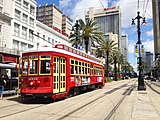Tram with suspended articulation

A tram with a suspended articulation is a type of tram or streetcar architecture with one or more articulations being suspended unlike an articulation resting on a jacobs bogie. This is similar to a saddle mounted vehicle being towed.[1]
The shortest examples consist of two sections. One section on two axles or two bogies; the other section rests both on one bogie and the other section, similar to a semi-trailer. In the diagram to the right, the short centre section supports the two end sections. Each of the end sections rests on one bogie and also on the centre section.[2] It is a popular tram/light rail architecture for vehicles in North America.[3]
History[edit]


In 1928 an experimental tram was constructed in Görlitz and then put into service in Dresden until the mid-1960s. This car was numbered 2501 and had three sections: the center section had four fixed wheels, both end sections had each only one adjustable axle.[4] Genoa was the first city to have a series of trams of this type. From 1940 onwards 31 trams were built by combining older tramcars. The lay out was very simple: the front section had one four wheeled truck, the end sections followed like a semi-trailer and had one fixed axle at the rear. The ride comfort was rather poor.[5]
The first newly build series appeared in Bremen in 1956. The only difference with the type in Genoa was that the end car hand a one-axle bogie and therefore slight improved ride qualities.[6] Vienna had an improved version of this type, with a two axle bogie at the end. This so-called Type F was longer than the version in Bremen and had a more streamlined design.[7]
Second generation[edit]
The second generation of trams all have a pivoting bogie both at the front and the end side. This way the ride is much smoother when entering curves. The first to use this concept was the Mirage type in Zürich in 1966. The center rests on a set of four fixed wheels.[8]
Low floor designs[edit]
The first modern low floor tram design also had floating articulations. Both Vevey and Duewag joined forces to create this tram type for the network in Geneva.[9] Though the design didn't have an entirely low floor, as it was still 48 cm above the rail. The second type (being named TFS-2) has a similar setup as the Mirage trams for Zürich. Using floating articulations, Alstom was able to create a low floor (less than 35 cm high) over 60% of the tramcar length.[10] Since the start of the Sheffield Supertram, it uses only vehicles with floating joints.[11] This setup is used for the majority of LRVs in North America.
Gallery[edit]
-
Coupled Green line LRVs in Boston
-
Coupled LRVs in Seattle
-
Coupled Green line LRVs in Portland
-
San Diego Trolley LRV
-
LRV in Birmingham (UK)
-
Tram train in Sheffield
-
Tram in Saint Petersburg
-
Tram in Melbourne
See also[edit]
References[edit]
- ^ "Saddle mount Definition". Law Insider. Retrieved 1 February 2024.
- ^ Urban Rail Transit (2022). Technical Comparison of Commercially Available Trams and Review of Standardization Frame and Design Principles. pp. 18, 19. Retrieved 1 February 2024.
- ^ "Low-floor light rail vehicles". Siemens Mobility Global. Retrieved 1 February 2024.
- ^ Kenning. "Damals in Dresden: Der Traum von der Schnellstraßenbahn (m22B)". Drehscheibe Online. Retrieved 1 February 2024.
- ^ Gragt, F. van der (1972). Moderne Trams: De ontwikkeling van de moderne tram in Europa van 1927 tot heden (in Dutch). Rotterdam: Wyt. p. 129. ISBN 9060075188.
- ^ "Museumstriebwagen 917". Retrieved 1 February 2024.
- ^ "Type F (1963-1996) – Straßenbahnjournal". www.strassenbahnjournal.at. Retrieved 1 February 2024.
- ^ "Adieu Mirage - Eine Ära geht zu Ende - Stadt Zürich". www.stadt-zuerich.ch (in German). 29 June 2010. Retrieved 1 February 2024.
- ^ Hondius, Harry (March 1993). "The development of low‐floor trams". Journal of Advanced Transportation. 27 (1): 80. doi:10.1002/atr.5670270108. ISSN 0197-6729.
- ^ Cambursano, Roberto; Gut, Martin (2022). Tram-Enzyklopädie: Geschichte und Technik der Strassenbahn. Freiburg im Breisgau: EK-Verlag. pp. 76, 77. ISBN 9783844668667.
- ^ "Vehicle information - Siemens Supertram". Retrieved 1 February 2024.









